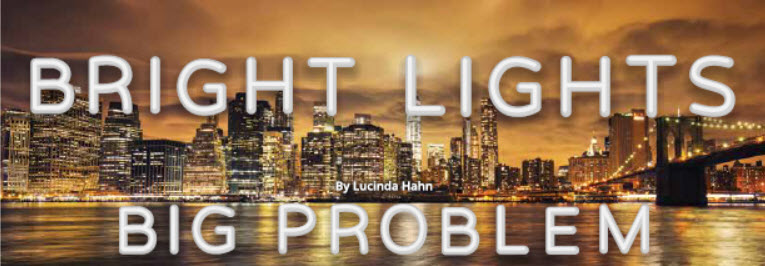Reprinted from our September 2021 issue…
Did you know that at least 2,500 stars should be visible at night? Yet in a typical American suburb, only a few hundred can be seen. And in large cities residents are lucky to glimpse a few dozen. This is due to “light pollution”, the excessive glow from street lamps, buildings, and homes where lights blaze through the night. Many people don’t know about light pollution’s negative effects. Here are a few along with some easy ways to help:
Animals
Scientists have documented it: excessive light at night harms dozens of species that rely on dark environments. For example, newly hatched turtles often mistake city lights for the moon’s shimmer on the ocean. This causes them to crawl toward urban developments rather than to the sea. Migrating birds are drawn to artificial light making them deviate from their route leading them to exhaustion and collapse. Light pollution also makes it harder for insects to navigate and breed. Fireflies for instance, have more difficulty seeing the bioluminescent cues they use to find mates. Light pollution even effects trees, plants, and microorganisms which harms ecosystems and disrupts food chains.
What you can do: At home, adopt a “dark sky-friendly” approach (which does not mean no lights at night). Sky-friendly fixtures are easy to find at local retail stores. You can install motion sensors or simply turn off unnecessary lights at bedtime.
Humans
Exposure to bright light at night can suppress melatonin, the chemical that regulates our sleep. Light pollution leads to less sleep and poorer sleep quality. It is also associated with increased risks for cancer, diabetes, and cardiovascular disease. Most harmful is “blue rich white light” that is often emitted by street lamps. The AMA has even issued guidance to help communities minimize street lighting’s detrimental effects.
What you can do: At bedtime close your curtains to street lamps and other artificial light. If you need outdoor lighting, be sure it doesn’t shine at neighbors’ windows (a growing problem known as “light trespass”). Ask your local public works department if your area’s streetlights are dark sky-friendly or in line with AMA guidelines.
Climate
Each year, U.S. residential outdoor lighting emits about 15 tons of CO2…the equivalent of 3 million passenger cars. To offset that carbon dioxide, we would need to plant about 600 million trees annually. Fortunately, cities from Paris, France to Santa Rosa, California have taken measures in recent years to reduce unnecessary lighting.
What you can do: Use lower cost LED lights outside., but don’t let that relax you into using them when they aren’t needed. Think twice about decorative lighting. They look great but their effects on the natural world are not.


